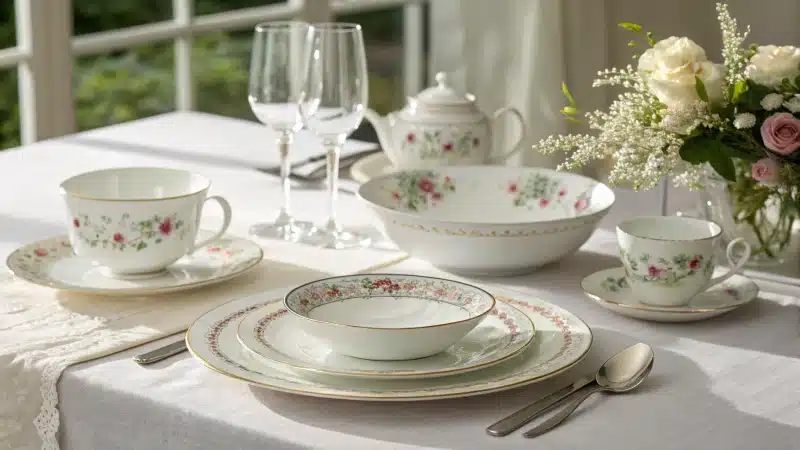
Ever found yourself torn between tradition and innovation when picking out dinnerware?
New bone china offers a compelling alternative to traditional bone china by delivering similar aesthetics and durability without using animal bone ash, making it more affordable and ethically appealing.
Thinking back to my first ceramic project, I remember the thrill of holding a finished piece in my hands. It was a simple cup, yet the satisfaction was immense. When it comes to choosing between new bone china and traditional bone china, the decision isn’t just about aesthetics. It’s about understanding the subtle differences that make each unique. New bone china mirrors the elegance and resilience of its traditional counterpart but does so while sidestepping the ethical concerns associated with using animal products.
In my years of crafting ceramics, I’ve seen how these modern alternatives can transform the dining experience—offering luxury without compromise. Let’s dive into what makes new bone china stand out and why it might just be the perfect fit for your table.
New bone china is more affordable than traditional bone china.True
New bone china avoids costly animal bone ash, reducing production costs.
Traditional bone china is more durable than new bone china.False
Both types offer similar durability due to comparable manufacturing processes.
What Are the Key Differences Between New Bone China and Traditional Bone China?
I remember the first time I held a piece of new bone china and wondered how it truly compared to traditional bone china. Dive into this world with me as I share what sets these two apart.
New bone china differs from traditional bone china primarily in composition and cost. While traditional bone china includes animal bone ash, new bone china uses alternative materials, making it more affordable and ethical.
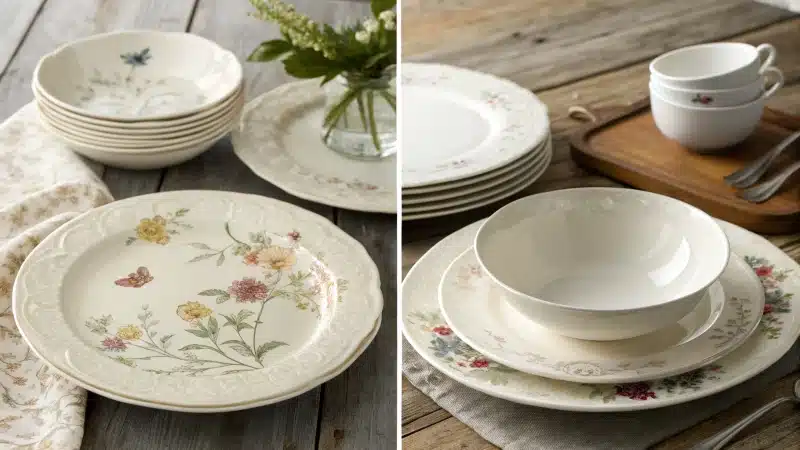
Composition and Materials
Let me take you back to when I first learned about the composition of traditional bone china. It was in a cozy ceramic workshop, surrounded by the warm glow of kilns. Traditional bone china, I discovered, contains at least 30% animal bone ash. This is what gives it that mesmerizing translucency1 and impressive strength. However, when I came across new bone china, I realized it uses alternative materials like calcium phosphate. It manages to maintain a similar look but without any animal products.
| Material | Traditional Bone China | New Bone China |
|---|---|---|
| Animal Bone Ash | Present | Absent |
| Calcium Phosphate | Absent | Present |
Manufacturing Process
In my years of experience, I’ve seen the meticulous process that goes into making traditional bone china. The firing techniques are precise, ensuring durability and brilliance. New bone china, on the other hand, adapts these processes to fit its unique composition while still delivering comparable quality and finish2. It’s fascinating to witness how these techniques evolve yet still honor tradition.
Aesthetic Appeal
Both types of china offer a luxurious aesthetic3 that perfectly complements formal dining settings. I remember setting a table with new bone china for a family gathering, and it blended seamlessly with the elegance we were aiming for. It’s remarkable how new bone china mimics the fine appearance of its traditional counterpart.
Cost and Accessibility
When it comes to cost, traditional bone china has always been on the pricier side due to its intricate production process. I remember saving up for a set that felt like owning a piece of art. New bone china, however, offers a more budget-friendly option, making luxurious dining experiences accessible to more people.
| Aspect | Traditional Bone China | New Bone China |
|---|---|---|
| Cost | Higher | Lower |
| Accessibility | Limited | More Accessible |
Ethical Considerations
If ethical consumption is something you care about, like me, then new bone china is an appealing choice. It’s animal-free yet doesn’t compromise on quality or style. This has been particularly important for me as I’ve explored vegan-friendly options4.
By delving into these aspects, you’ll be better equipped to choose the type of china that aligns with your personal values and needs. Whether you prioritize aesthetics, cost-efficiency, or ethical considerations, understanding these key differences will help guide your decision-making process.
Traditional bone china contains animal bone ash.True
Traditional bone china includes at least 30% animal bone ash for strength.
New bone china is more expensive than traditional bone china.False
New bone china is generally cheaper due to its alternative materials.
How Does the Absence of Animal Bone Ash Affect the Quality of New Bone China?
Ever wondered what happens to bone china without the bone ash? Let’s explore this intriguing shift.
The absence of animal bone ash in new bone china affects its translucency and strength but maintains a fine appearance and resilience. It offers ethical benefits and versatility in design, appealing to a broader audience.
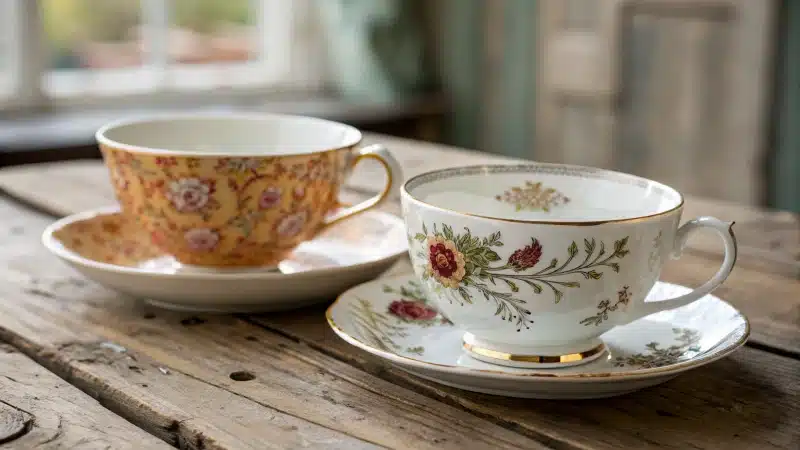
The Role of Animal Bone Ash in Traditional Bone China
I remember the first time I held a piece of traditional bone china in my hands. It felt almost magical—its delicate translucency and smooth, milky white surface seemed almost too perfect to use. This ethereal quality largely comes from the animal bone ash used in its production. The bone ash not only gives it that beautiful glow but also makes it incredibly strong and durable, which is why it’s been a staple at fine dining tables for centuries.
New Bone China: Quality Without Bone Ash
When I first heard about new bone china, I was intrigued by how it could replace animal bone ash yet still promise durability and beauty. By using alternative materials like calcium phosphate, new bone china slightly shifts its translucency but continues to shine in terms of aesthetic appeal. In my work, I’ve seen how manufacturers are constantly tweaking formulas to ensure that new bone china5 doesn’t just look good but also stands up to everyday use.
| Property | Traditional Bone China | New Bone China |
|---|---|---|
| Translucency | High | Slightly Less |
| Durability | Very High | High |
| Ethical Concerns | Yes | No |
Designing for Modern Tastes
I’ve noticed a growing shift towards more ethically-conscious products, and new bone china fits right into this trend. By avoiding animal-derived materials, designers now have the freedom to experiment with innovative designs that speak to modern tastes. It’s exciting to see how these products resonate with consumers who value both aesthetics and ethics.
Cost and Market Impact
One of the surprising benefits of new bone china is its affordability. With production processes generally being less expensive than traditional methods, I’ve been able to offer beautiful ceramics at lower costs, making them accessible to a wider audience. This shift has not only driven market demand but also allowed more people to enjoy luxurious dining experiences without the hefty price tag.
Explore more about ceramic manufacturing6 and its impact on the market to understand the broader implications of these materials.
Future Trends in Ceramic Tableware
As someone deeply embedded in the ceramics industry, I can tell you that sustainability is no longer just a buzzword—it’s a direction we’re all moving towards. The trend towards using non-animal derived materials like those in new bone china continues to grow as manufacturers innovate with materials that offer both aesthetic and ethical advantages.
To delve deeper into sustainable ceramics7, you can explore how industries are shifting towards eco-friendly practices without compromising on quality or design.
New bone china is less translucent than traditional.True
Replacing bone ash with alternatives reduces translucency slightly.
New bone china is more expensive to produce.False
Production costs are lower, making it more affordable.
Is New Bone China a Sustainable and Ethical Choice?
Ever wondered if your elegant dinnerware could also be kind to the planet and our furry friends?
New bone china is considered more ethical than traditional bone china as it eliminates the use of animal bones. However, its sustainability depends on production practices and resource management.
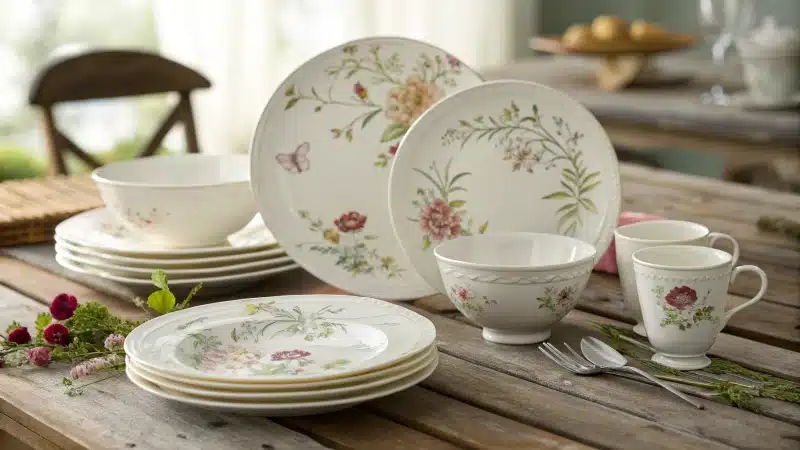
Understanding New Bone China
When I first came across new bone china, I was intrigued by its promise of tradition without the ethical baggage. Imagine hosting a dinner party with stunning, delicate plates that look just like traditional bone china, but without any animal products. New bone china achieves this by swapping out animal bone ash for synthetic or alternative materials. This means not only can I enjoy the beautiful finish of bone china, but I can do so with a clearer conscience knowing I’m not contributing to animal exploitation.
- Traditional Bone China: Think of it as the old-school porcelain; it’s beautiful but involves using animal bone ash, which many, including myself, find problematic.
- New Bone China: Offers the same elegance but uses humane alternatives.
Environmental Impact
Of course, the journey doesn’t end at ethics. I remember wondering about the environmental side of things. While new bone china avoids ethical pitfalls related to animal welfare, its overall green credentials hinge on how it’s made.
Considerations:
- Energy Consumption: Producing ceramics is no small feat in terms of energy. So, I always ask about the carbon footprint.
- Waste Management: It turns out that effective recycling and waste management can significantly boost sustainability.
| Factor | Traditional Bone China | New Bone China |
|-------------------|------------------------|----------------|
| Animal Welfare | No | Yes |
| Energy Use | High | Moderate |
| Waste Production | Significant | Controlled |Industry Practices and Innovations
In my years in the ceramics industry, I’ve seen firsthand how it’s pivoting towards more eco-friendly practices. Manufacturers are embracing new technologies that promise less harm to our planet:
- Eco-Friendly Kilns: These beauties lower emissions with advanced tech.
- Resource Efficiency: Imagine crafting with almost zero wastage—amazing, right?
- Recycling Initiatives: We’re talking about giving ceramic scraps a second life.
Consumer Influence
I often tell my clients that they have the power to drive change. By opting for new bone china, we collectively push manufacturers toward sustainable innovations and ethical practices8.
- Market Trends: There’s a noticeable shift towards ethical products.
- Certifications: Always check for those sustainability badges—they’re your best friend in making informed purchases.
Comparison with Other Ceramics
New bone china competes head-on with other ceramic types like stoneware and porcelain. Each has its perks and quirks:
- Porcelain: Tough and timeless, but energy-heavy in production.
- Stoneware: Durable with design flexibility.
- New Bone China: Merges beauty with ethics seamlessly.
For me, making choices that reflect my values while still enjoying aesthetic beauty feels like a win-win. Exploring these options empowers us to make decisions that marry style with substance, ensuring our dining experiences are both delightful and planet-friendly.
New bone china contains animal bone ash.False
New bone china uses synthetic materials, not animal bone ash.
New bone china has a lower environmental impact than traditional.True
It reduces animal exploitation and can have controlled waste production.
Which Type of China Best Suits Everyday Use and Special Occasions?
Remember the joy of setting the perfect table for dinner parties? The right china makes all the difference, adding elegance and charm to any meal.
For everyday use and special occasions, new bone china offers the ideal blend of durability, aesthetic appeal, and cost-effectiveness. It maintains the elegance of traditional bone china without the ethical concerns, making it versatile and appealing.
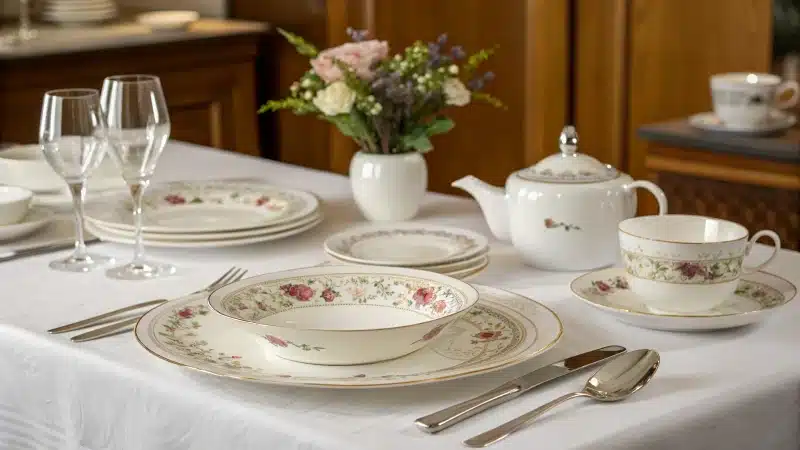
Exploring Different Types of China
I remember when I first started MTCeramic; I was fascinated by the variety of china available. Each type seemed to tell its own story. Traditional bone china, with its delicate yet resilient nature, contains animal bone ash, offering a classic choice but often at a higher price point. On the other hand, new bone china emerged as a compelling alternative for those of us who appreciate elegance but prefer a cruelty-free option.
| Type of China | Key Features |
|---|---|
| Traditional Bone | Contains bone ash; elegant but costly |
| New Bone | Animal-free; durable and affordable |
| Porcelain | High temperature fired; less durable than bone |
New Bone China: A Versatile Choice
New bone china caught my attention because of its versatile designs9 and affordability. I quickly realized it wasn’t just for special occasions. With its luxurious appeal, it’s become a favorite in my home for everything from casual family dinners to more formal gatherings. Its resilience means it can handle everyday use without losing its charm.
Considering Porcelain and Other Options
Of course, porcelain holds a special place for those who love simplicity. While it’s not as strong as bone china, it’s a beautiful choice for settings where understated elegance is desired. I’ve often recommended exploring different porcelain varieties10 to match specific needs. And let’s not forget stoneware, which offers a different aesthetic quality that’s equally charming in its own right.
Traditional bone china contains animal bone ash.True
Traditional bone china includes animal bone ash, enhancing strength.
Porcelain is more durable than traditional bone china.False
Porcelain is less durable than traditional bone china.
Conclusion
New bone china offers an ethical, affordable alternative to traditional bone china, maintaining similar aesthetics and durability without animal products, making it suitable for everyday use and special occasions.
-
Explore how animal bone ash contributes to the unique translucency of traditional bone china. ↩
-
Discover the detailed manufacturing steps that ensure quality and durability in traditional bone china. ↩
-
Learn about the factors that give bone china its luxurious appearance. ↩
-
Find out more about tableware options that are suitable for vegan consumers. ↩
-
Learn about the differences between new and traditional bone china, focusing on materials and quality. ↩
-
Understand the intricacies of ceramic manufacturing and how innovations affect production. ↩
-
Explore how sustainability is being integrated into ceramic production, enhancing eco-friendliness. ↩
-
Understand how consumer choices promote eco-friendly practices in the ceramics industry. ↩
-
Discover the diverse design options available with new bone china that make it suitable for multiple dining settings. ↩
-
Explore the different types of porcelain available and their best uses to find the perfect fit for your dining needs. ↩